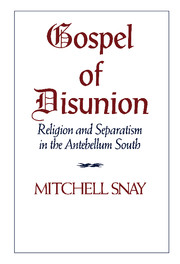Book contents
- Frontmatter
- Contents
- Acknowledgments
- Introduction: Religion and the search for Southern distinctivenes
- PART ONE RELIGION AND SECTIONAL POLITICS
- 1 The abolitionist crisis of 1835: The issues defined
- PART TWO RELIGION AND SLAVERY
- PART THREE RELIGION AND SEPARATISM
- Conclusion: Religion, the origins of Southern nationalism, and the coming of the Civil War
- Bibliography
- Index
1 - The abolitionist crisis of 1835: The issues defined
from PART ONE - RELIGION AND SECTIONAL POLITICS
Published online by Cambridge University Press: 07 September 2010
- Frontmatter
- Contents
- Acknowledgments
- Introduction: Religion and the search for Southern distinctivenes
- PART ONE RELIGION AND SECTIONAL POLITICS
- 1 The abolitionist crisis of 1835: The issues defined
- PART TWO RELIGION AND SLAVERY
- PART THREE RELIGION AND SEPARATISM
- Conclusion: Religion, the origins of Southern nationalism, and the coming of the Civil War
- Bibliography
- Index
Summary
In May 1835, the American Antislavery Society announced its intention to “sow the good seed of abolition thoroughly over the whole country.” Lewis Tappan, prominent evangelical abolitionist from New York and member of the society's executive committee, devised the plan to flood the nation with antislavery pamphlets, kerchiefs, medals, and even blue wrappers around chocolate. The names of 20,000 Southerners appeared on Tappan's mailing list. Targeting the South, suggested the antislavery newspaper Emancipator, would force Southerners to show “their real views and feelings.”
These words proved prophetic. On July 29, 1835, the steam packet Columbia arrived in Charleston from New York with thousands of antislavery tracts in its hold. No sooner had the boat arrived than a group of angry citizens snatched these mail bags from the post office. The next evening 3,000 Charlestonians gathered at the Parade Ground and watched as this antislavery literature, along with effigies of Tappan and two other leading abolitionists, was burned. The bonfires that night in the summer of 1835 provided unmistakable evidence of the “real views and feelings” of the South. The abolitionist crusade to end slavery would be met by swift and stiff resistance by the slaveholding states.
By confronting the South with an assault on the morality of slavery, the postal campaign of 1835 created a political crisis that drew Southern ministers into sectional politics. Their first important confrontation with Northern abolitionists prefigured the ways in which religion would help shape antebellum Southern distinctiveness.
- Type
- Chapter
- Information
- Gospel of DisunionReligion and Separatism in the Antebellum South, pp. 19 - 50Publisher: Cambridge University PressPrint publication year: 1993



